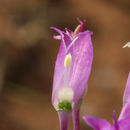Comments
provided by eFloras
The varieties of Allium bolanderi are extremely difficult to distinguish in the absence of bulb material. Care must be taken to obtain good bulb material whenever collecting Allium, but it is extremely critical in this species.
- license
- cc-by-nc-sa-3.0
- copyright
- Missouri Botanical Garden, 4344 Shaw Boulevard, St. Louis, MO, 63110 USA
Description
provided by eFloras
Bulbs 1–6+, not basally clustered, replaced annually by new bulbs borne terminally on rhizomes; rhizomes 1–3, inconspicuous, slender, less than 2 cm including renewal bulb; parent bulbs disappearing by anthesis except for still-functional roots and bulb coat, oblique-ovoid to ± oblong, 0.7–1.4 × 0.5–1.2 cm; outer coats not enclosing bulbs, brown to gray-brown, ± obscurely reticulate, membranous, reticulum delicate, cells transversely elongate, V-shaped or ± wavy, forming obscure herringbone pattern, without fibers; inner coats white, cells obscure, quadrate to ± rectangular, often contorted. Leaves persistent, withering from tip at anthesis, 2–3, basally sheathing, sheaths not extending much above soil surface; blade solid, subterete to ± channeled, 9–30 cm × 1–2 mm, margins entire. Scape persistent, solitary, erect, solid, terete, 10–35 cm × 1–3 mm. Umbel persistent, erect, compact to loose, 10–20-flowered, hemispheric, bulbils unknown; spathe bracts persistent, 2, 4–6-veined, lanceolate to lance-ovate, ± equal, apex acuminate. Flowers conic to campanulate, 7–14 mm; tepals erect, reddish purple, rarely white, narrowly lanceolate to lance-ovate, ± equal, becoming rigid and carinate in fruit, margins finely denticulate (inner tepal more prominently so), apex acute to obtuse, becoming involute at tip and appearing acuminate; stamens included; anthers yellow; pollen yellow; ovary crested; processes 3, central, 2-lobed, minute, margins entire; style linear, equaling stamens; stigma capitate, obscurely 3-lobed, scarcely thickened; pedicel 10–20 mm. Seed coat dull; cells minutely roughened.
- license
- cc-by-nc-sa-3.0
- copyright
- Missouri Botanical Garden, 4344 Shaw Boulevard, St. Louis, MO, 63110 USA
Allium bolanderi: Brief Summary
provided by wikipedia EN
Allium bolanderi is a species of wild onion known by the common name Bolander's onion. It is native to northern California and southwestern Oregon, where it grows in the rocky soils of the Klamath Mountains and surrounding regions.
Allium bolanderi grows from an oval-shaped bulb up to 2 cm (3⁄4 in) long with associated rhizomes. The stem reaches about 35 cm (14 in) in maximum height and there are two or three long, cylindrical leaves about the same length as the stem. The inflorescence contains 10 to 20 reddish-purple, or occasionally white, flowers, each with very finely toothed tepals.
Two varieties are recognized:
Allium bolanderi var. bolanderi Allium bolanderi var. mirabile (L.F.Hend.) McNeal
- license
- cc-by-sa-3.0
- copyright
- Wikipedia authors and editors

